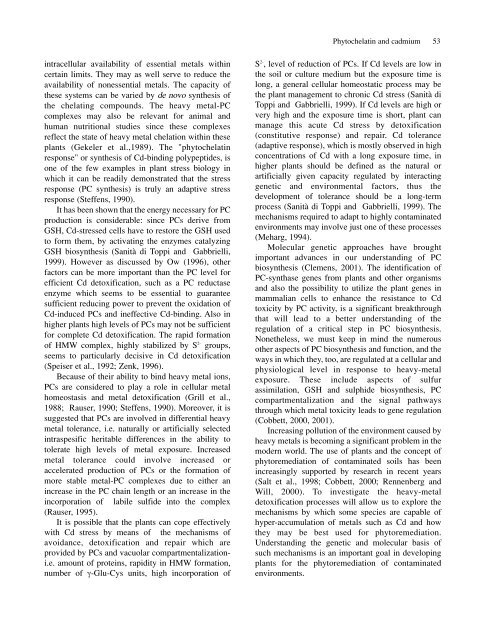Full Journal - Journal of Cell and Molecular Biology - Haliç Üniversitesi
Full Journal - Journal of Cell and Molecular Biology - Haliç Üniversitesi
Full Journal - Journal of Cell and Molecular Biology - Haliç Üniversitesi
You also want an ePaper? Increase the reach of your titles
YUMPU automatically turns print PDFs into web optimized ePapers that Google loves.
intracellular availability <strong>of</strong> essential metals within<br />
certain limits. They may as well serve to reduce the<br />
availability <strong>of</strong> nonessential metals. The capacity <strong>of</strong><br />
these systems can be varied by de novo synthesis <strong>of</strong><br />
the chelating compounds. The heavy metal-PC<br />
complexes may also be relevant for animal <strong>and</strong><br />
human nutritional studies since these complexes<br />
reflect the state <strong>of</strong> heavy metal chelation within these<br />
plants (Gekeler et al.,1989). The "phytochelatin<br />
response" or synthesis <strong>of</strong> Cd-binding polypeptides, is<br />
one <strong>of</strong> the few examples in plant stress biology in<br />
which it can be readily demonstrated that the stress<br />
response (PC synthesis) is truly an adaptive stress<br />
response (Steffens, 1990).<br />
It has been shown that the energy necessary for PC<br />
production is considerable: since PCs derive from<br />
GSH, Cd-stressed cells have to restore the GSH used<br />
to form them, by activating the enzymes catalyzing<br />
GSH biosynthesis (Sanità di Toppi <strong>and</strong> Gabbrielli,<br />
1999). However as discussed by Ow (1996), other<br />
factors can be more important than the PC level for<br />
efficient Cd detoxification, such as a PC reductase<br />
enzyme which seems to be essential to guarantee<br />
sufficient reducing power to prevent the oxidation <strong>of</strong><br />
Cd-induced PCs <strong>and</strong> ineffective Cd-binding. Also in<br />
higher plants high levels <strong>of</strong> PCs may not be sufficient<br />
for complete Cd detoxification. The rapid formation<br />
<strong>of</strong> HMW complex, highly stabilized by S 2- groups,<br />
seems to particularly decisive in Cd detoxification<br />
(Speiser et al., 1992; Zenk, 1996).<br />
Because <strong>of</strong> their ability to bind heavy metal ions,<br />
PCs are considered to play a role in cellular metal<br />
homeostasis <strong>and</strong> metal detoxification (Grill et al.,<br />
1988; Rauser, 1990; Steffens, 1990). Moreover, it is<br />
suggested that PCs are involved in differential heavy<br />
metal tolerance, i.e. naturally or artificially selected<br />
intraspesific heritable differences in the ability to<br />
tolerate high levels <strong>of</strong> metal exposure. Increased<br />
metal tolerance could involve increased or<br />
accelerated production <strong>of</strong> PCs or the formation <strong>of</strong><br />
more stable metal-PC complexes due to either an<br />
increase in the PC chain length or an increase in the<br />
incorporation <strong>of</strong> labile sulfide into the complex<br />
(Rauser, 1995).<br />
It is possible that the plants can cope effectively<br />
with Cd stress by means <strong>of</strong> the mechanisms <strong>of</strong><br />
avoidance, detoxification <strong>and</strong> repair which are<br />
provided by PCs <strong>and</strong> vacuolar compartmentalizationi.e.<br />
amount <strong>of</strong> proteins, rapidity in HMW formation,<br />
number <strong>of</strong> γ-Glu-Cys units, high incorporation <strong>of</strong><br />
Phytochelatin <strong>and</strong> cadmium 53<br />
S 2- , level <strong>of</strong> reduction <strong>of</strong> PCs. If Cd levels are low in<br />
the soil or culture medium but the exposure time is<br />
long, a general cellular homeostatic process may be<br />
the plant management to chronic Cd stress (Sanità di<br />
Toppi <strong>and</strong> Gabbrielli, 1999). If Cd levels are high or<br />
very high <strong>and</strong> the exposure time is short, plant can<br />
manage this acute Cd stress by detoxification<br />
(constitutive response) <strong>and</strong> repair. Cd tolerance<br />
(adaptive response), which is mostly observed in high<br />
concentrations <strong>of</strong> Cd with a long exposure time, in<br />
higher plants should be defined as the natural or<br />
artificially given capacity regulated by interacting<br />
genetic <strong>and</strong> environmental factors, thus the<br />
development <strong>of</strong> tolerance should be a long-term<br />
process (Sanità di Toppi <strong>and</strong> Gabbrielli, 1999). The<br />
mechanisms required to adapt to highly contaminated<br />
environments may involve just one <strong>of</strong> these processes<br />
(Meharg, 1994).<br />
<strong>Molecular</strong> genetic approaches have brought<br />
important advances in our underst<strong>and</strong>ing <strong>of</strong> PC<br />
biosynthesis (Clemens, 2001). The identification <strong>of</strong><br />
PC-synthase genes from plants <strong>and</strong> other organisms<br />
<strong>and</strong> also the possibility to utilize the plant genes in<br />
mammalian cells to enhance the resistance to Cd<br />
toxicity by PC activity, is a significant breakthrough<br />
that will lead to a better underst<strong>and</strong>ing <strong>of</strong> the<br />
regulation <strong>of</strong> a critical step in PC biosynthesis.<br />
Nonetheless, we must keep in mind the numerous<br />
other aspects <strong>of</strong> PC biosynthesis <strong>and</strong> function, <strong>and</strong> the<br />
ways in which they, too, are regulated at a cellular <strong>and</strong><br />
physiological level in response to heavy-metal<br />
exposure. These include aspects <strong>of</strong> sulfur<br />
assimilation, GSH <strong>and</strong> sulphide biosynthesis, PC<br />
compartmentalization <strong>and</strong> the signal pathways<br />
through which metal toxicity leads to gene regulation<br />
(Cobbett, 2000, 2001).<br />
Increasing pollution <strong>of</strong> the environment caused by<br />
heavy metals is becoming a significant problem in the<br />
modern world. The use <strong>of</strong> plants <strong>and</strong> the concept <strong>of</strong><br />
phytoremediation <strong>of</strong> contaminated soils has been<br />
increasingly supported by research in recent years<br />
(Salt et al., 1998; Cobbett, 2000; Rennenberg <strong>and</strong><br />
Will, 2000). To investigate the heavy-metal<br />
detoxification processes will allow us to explore the<br />
mechanisms by which some species are capable <strong>of</strong><br />
hyper-accumulation <strong>of</strong> metals such as Cd <strong>and</strong> how<br />
they may be best used for phytoremediation.<br />
Underst<strong>and</strong>ing the genetic <strong>and</strong> molecular basis <strong>of</strong><br />
such mechanisms is an important goal in developing<br />
plants for the phytoremediation <strong>of</strong> contaminated<br />
environments.

















